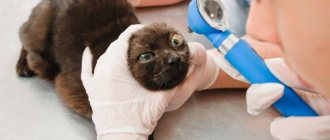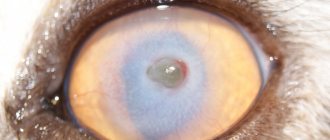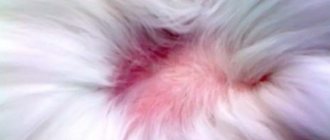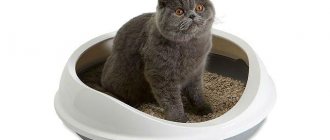When your pet feels unwell, it will not be able to tell its owner how it is feeling. It is necessary to monitor the external condition and behavior of your furry friend daily. Pets are often the target of blepharitis. In cats, this is a fairly common disease of the mucous part of the eye. If you do not respond to lacrimation, the contaminated part of the mucous membrane, you can get serious complications that will result in partial loss of vision and absolute blindness.
Blepharitis in cats: symptoms and treatment
The concept of blepharitis in veterinary medicine
Blepharitis is inflammation of the eyelids. The disease is common to all domestic animals, from dogs to hamsters. Cats are no exception.
Pet owners often confuse blepharitis with ordinary conjunctivitis, which can be treated on their own. However, the use of external solutions, washing with herbal decoctions and applying ointments do not bring the desired result, but, on the contrary, complicate the situation. The animal's condition is deteriorating day by day. In order to diagnose blepharitis in a timely manner, at the slightest suspicion of eye disease, you should see a veterinarian. With prompt intervention and properly selected treatment, this disease is eliminated quite quickly.
Blepharitis is inflammation of the eyelids
Types of blepharitis
There are several varieties of this disease, depending on the form of the disease and the causes of the lesion. Highlight:
- anterior, in which only the edge of the eyelids along the growth of the eyelashes is affected;
- in the posterior case, the meibomian glands are affected;
- angular affects the mucous corners of the eyes.
Table. Main types of blepharitis
| No | View | Description |
| 1 | Simple | It is characterized by redness of the eyelid and thickening at the edges. Purulent discharge accumulates in the corners of the eye. Meibomian glands expand |
| 2 | Scaly | The eyelid is subject to severe swelling and redness. Purulent inflammation forms. White fluid accumulates in the corners of the eyes. Scales appear along the eyelash line, reminiscent of dandruff. Very often complicated by conjunctivitis |
| 3 | Ulcerative | Develops along with the purulent process. Ulcers affect the roots of the hair. The eyelids turn red and swell. Yellowish dandruff appears. When the ulcers are affected, a bleeding ulcer appears. In the absence of a proper response, the development of various pathogens is possible |
| 4 | Demodectic | The cause of this disease is tick infection. The disease is possible due to a weakened immune system. Inflammation appears in the eyelid area. This form is difficult to diagnose and difficult to treat. Most often ends with surgery |
| 5 | Allergic | Redness and swelling of the eyelids, severe itching, aversion to light, lacrimation. The cat behaves restlessly, rubbing its eyes with its paw and on the furniture. Most often occurs due to poor diet or contact with chemicals. |
| 6 | Meibomian | Settles in the meibomian glands. The eyelashes stick together and yellow pus forms on them. A thick white substance and mucus appears in the corners of the eyes |
| 7 | Phlegmonous | Unilateral form of blepharitis. Accompanied by high temperature. There is pus in the corners of the eyes. The tissue on the eyelids becomes scarred. In the absence of a proper response, necrosis occurs |
Video - First signs of eye disease in dogs and cats
Removal operation
Neoplasms 5 mm in size, long-existing or prone to recurrence must be removed surgically. The operation is usually performed on an outpatient basis, under local anesthesia, and its duration does not exceed 20–30 minutes. The doctor grabs the area of the eyelid with the chalazion using a fenestrated clamp, then opens the neoplasm and removes it along with the capsule. If there is a fistula tract, it is opened and excised along its entire length. After several stitches are placed, a pressure bandage is applied to the area of the operated eye. For a week after surgery, you will need to instill anti-inflammatory drops or apply ointment.
Causes of blepharitis
There are many factors that lead to inflammation of the eyelid margin in pets.
- Among the most common causes are burns, including chemical ones.
- If your pet has recently taken any medications to treat another condition, the medications may have caused this reaction in the eyes.
- Incorrectly selected food can also lead to similar diseases.
- But the most common cause is various mechanical damage to the cornea or eyelids.
- If your cat often goes outside, then you shouldn’t rule out a fungal infection.
- Very often, inflammation appears against the background of renal failure.
In any case, blepharitis does not occur just like that, but is a consequence of serious problems with the pet’s health.
Incorrectly selected food can cause the development of eye diseases in cats.
Going to the veterinarian is not only about prescribing treatment. The doctor must find out the cause in order to prevent relapse in the future. The veterinarian checks whether the inflammation is due to:
- parasitic infestations;
- disturbances in the functioning of the endocrine system;
- autoimmune diseases;
- dysfunction of the sebaceous glands.
Depending on the cause of blepharitis, the symptoms of this disease also differ. Very often, correctly identified symptoms allow you to quickly find out the cause, eliminate the irritating factor and subsequently protect the animal from trouble.
Indications for surgical removal of chalazion
Chalazion removal is indicated under the following circumstances:
- Conservative treatment was ineffective.
- the effect of conservative treatment is short-term.
- The size of the chalazion exceeds 5 mm in diameter.
- any complications (impaired vision quality, infection, etc.).
- frequent relapses of chalazion.
This list of indications for surgical removal of a chalazion can be expanded at the discretion of the attending physician.
Symptoms of blepharitis in cats
Symptoms vary depending on the type of disease. In 80% of cases, veterinarians are faced with redness of the eyelid and its inflammation. Clear or purulent discharge appears in the corners. The pet is nervous and tries to scratch the inflamed area. Such actions are aimed at eliminating itching. Gradually, the size of the eyes begins to decrease, the pet is limited in the viewing angle.
Advanced blepharitis
Against the background of blepharitis, conjunctivitis often begins to develop. Depending on the expression of symptoms, you can understand how long the disease lasts.
Purulent discharge from blepharitis in cats
But, in addition to standard symptoms, there are also specific manifestations. For example, if we are talking about a fungal disease. Cat owners note that against the background of this disease they experience eyelash loss and baldness in the eye area.
If the cause of the disease is autoimmune processes, blistering formations can be found on the cat’s body. In such a situation, a biopsy is required to make a correct diagnosis.
Blistering formations in blepharitis
When inflammation is caused by infection, this is indicated by the animal's painful condition. The cat becomes lethargic, apathetic, eats and drinks practically nothing. As the disease progresses, the animal's body begins to feel feverish. In case of infection, antibacterial therapy should be started immediately.
Veterinarians often encounter scaly blepharitis. With this type, the eyelids turn red and swelling spreads. The edge of the eyelid thickens and becomes dense. Against the background of this process, the shape of the eyes narrows. Gray small scales form in the eyelash growth area, which affect eyelash loss. If the scales begin to fill with pus, then the disease develops into an ulcerative condition. This disease develops much faster. The wounds begin to scar, and the eyelid literally turns in the opposite direction.
Diagnosis of blepharitis
The owner of the animal can easily notice the symptoms of blepharitis on his own, at home. But for an accurate diagnosis you need to see a veterinarian.
If you suspect blepharitis, you should immediately consult a veterinarian
Proper inspection requires special equipment. The veterinarian's office should have a slit lamp. The doctor examines the animal and, if possible, collects a complete medical history. In the initial stages of blepharitis, it is necessary to exclude other diseases whose symptoms are similar. The examination begins with an assessment of the general condition of the animal and the degree of damage to the eyelids. If the damage is significant, symptomatic treatment is prescribed, which must be started immediately to preserve the cat’s vision. If the doctor suspects a fungal or infectious nature of the lesion, scrapings are taken from the inflamed area of the eyelids. A complete blood test is required to assess the cat's condition.
If it is impossible to identify the cause by examination, the eyelid tissue is taken for a biopsy. After the test results have been received, the doctor makes a diagnosis and develops a treatment regimen. It is necessary to see a veterinarian once a week to assess the animal’s condition and make possible changes to the regimen.
If a disease is suspected, a general blood test is required to assess the cat's condition.
FAQ
Chalazion is a fairly common disease. In this regard, patients often have the following questions:
Are styes and chalazions the same thing? No. Barley is an inflammation of the hair follicle (eyelash), and a chalazion develops in the thickness of the eyelid itself. In addition, barley has an acute course - it ripens within 3-4 days, after which it often opens spontaneously, releasing purulent contents. Chalazion progresses slowly, and suppuration is observed very rarely.
Can a stye turn into a chalazion? No, he can not. But the frequent appearance of styes may indicate health problems, which themselves can provoke blockage of the meibomian gland. In addition, frequent styes can cause microscopic scar changes in the tissues of the eyelids, and this becomes a prerequisite for blockage of the meibomian gland ducts.
Is the tendency to form chalazions inherited? No hereditary link has been identified, but some diseases of the endocrine system or other diseases that increase the likelihood of developing a chalazion can be passed on from parents to children. Familial cases of chalazion, which affects all or many members of the family, are more likely to be associated with hygiene habits (for example, lack of habit of washing hands before washing the face) rather than with genetic factors.
Can a new chalazion form in place of the removed one? This doesn't happen often, but it's still a possibility. To minimize such situations, it is important to identify the cause of chalazion formation, since many of them can be eliminated (for example, nutritional disorders, untreated diseases of the gastrointestinal tract, etc.).
Who is more likely to get chalazion? For those who are in one way or another predisposed to blockage of the meibomian gland ducts (anatomical features of the structure of the ducts, frequent inflammatory or infectious eye diseases, neglect of hygiene rules, etc.).
What to do if a chalazion appears? Contact your doctor. Although chalazion does not pose an immediate threat to health and life, it can cause infectious complications. In addition, in older people, a malignant neoplasm can be “masked” as a chalazion.
All questions you are interested in can be asked by phone (calls from mobile phones and regions of the Russian Federation are free) and by phone in Moscow or online using the appropriate form on the website.
Author:
Mironova Irina Sergeevna 5/5 (1 rating)
Honey. portal:
Treatment
Depending on the degree of development of the disease, its cause and the type of blepharitis itself, an individual treatment method is prescribed. Most often, approaches are symptomatic or complex.
Symptomatic treatment is aimed at eliminating symptoms. Very often, such a regimen is prescribed if the animal has received the disease as a result of mechanical damage. If the cause is an infection, fungus, or other problems related to the pet’s health, then comprehensive treatment is prescribed. When the case is advanced, the doctor will suggest surgical intervention to preserve the animal’s vision and save it from suffering.
Depending on the degree of development of the disease, cause and type, an individual treatment method is prescribed
When a microorganism becomes the cause of the disease, a course of antibiotic therapy is prescribed. If a subcutaneous tick is detected in the body of an animal, three-time vaccination is prescribed with intervals of 15 days. Additionally, a fungicidal ointment is used to destroy microsporia.
You can read more about antibiotics for cats in a special article on our website.
Antibiotics are used both in the form of ointments and in the form of injections. But not all treatment can be carried out by the owner at home. Several times a month you will have to visit the veterinarian to administer antibacterial emulsions and suspensions to the affected area of blepharitis.
With the permission of a doctor, you can use traditional medicine methods. These are lotions, oil complexes, habitats, homemade drops.
With the permission of a doctor, you can use traditional medicine methods
With such an integrated approach, rest, proper nutrition and avoidance of contact with external irritants (no street walks), the animal will recover in a matter of days, and after a month it will completely forget about the illness it experienced.
Medications
In the treatment of blepharitis, veterinarians insist on the use of medications. Thanks to medications, you can achieve a quick effect without possible complications.
- To wash the eyes and remove crusts, use a mixture of petroleum jelly, soda and warm water. After mixing the ingredients in equal proportions, soak a cotton swab in the solution. Carefully treat the cat's eyes, removing crusts and scales along the way.
- Most often, veterinarians prescribe syntomycin emulsion. It relieves inflammation and prevents redness. Along with the emulsion, tetracycline and yellow-mercury ointment (one percent) have the same effect.
- Rinsing the animal's eyes with a salt solution will be an excellent remedy for ulcers.
- Iris eye drops prevent the onset of complications such as conjunctivitis. The frequency of use depends on the body weight and age of the animal.
- In the first week of treatment, veterinarians advise purchasing a special protective collar that is fixed around the neck. This will prevent your animal from scratching its eyes.
Eye drops "Iris"
Homemade eye washes
Every day, several times a day, it is necessary to clean the eye area from pus, crusts, and mucus. Not only medicinal solutions are suitable for this, but also herbal decoctions. The effectiveness of these solutions will depend on proper preparation.
- Chamomile and calendula decoction. 2 teaspoons of dried flowers should be poured with boiling water in an amount of 250 ml. Cover the container with a lid and leave for 15 minutes. The broth is filtered through multilayer gauze. Can only be used after cooling.
- Brew weak black tea. Cool the solution and strain it. Rub the animal's eyes.
- A mixture of dry sage and St. John's wort should be poured into 250 ml of boiling water. Let it brew for 15 minutes. Rinse eyes after cooling.
A decoction of chamomile and calendula is used to wash the eyes for blepharitis.
Washing procedure
In addition to the correct preparation of the product, it is important to approach the procedure itself correctly. Otherwise, you risk causing harm.
- Wash your hands thoroughly and treat with antiseptic.
- Adjust the time so that the cat is as relaxed as possible and not in a state of activity.
- Prepare the required solution in advance and cool it.
- Take a clean gauze pad. Lightly moisten it in the broth.
- Start wiping the eye area from the ear to the nose, trying to get the water into the inner part of the eyelid. You should not press, the movements should be light and pleasant.
- Wipe the treated area with dry gauze or a napkin.
Important! A new, clean cotton swab is used for each eye.
If after using the decoction you notice that the situation has worsened sharply, you should visit a veterinarian.
Use a new, clean cotton swab to wipe each eye
Correctly selected posture during the procedure will provide you with the desired result. Wrap the cat in a diaper or towel and lay it on its back. It is advisable for the animal to sit on your lap. Try to keep the light out of the cat's eyes, otherwise she will squint and the procedure will not bring the desired results.
Try not to touch the cornea of the eye, this is the most painful area with blepharitis. To consolidate the result, you can rinse your eyes with a syringe.
Video - How to wash a cat's eyes?
Prevention
According to statistics, about 20% of furry pets suffer from blepharitis. And only 7% of them are diagnosed with this disease and treated in accordance with the recommendations of the veterinarian. Other animals either cope with such a scourge on their own or lose their sight. It is important to prevent the disease in your pet so as not to face a complex treatment process in the future.
- Vaccination. Don't forget about your pet's annual vaccination. It will protect your cat from trichophytosis and various viral diseases.
- Walks. To avoid becoming a victim of bacteria and subcutaneous mites, you need to carefully choose places for walking. Try to minimize your pet's contact with street animals.
- Owner hygiene. Wash your hands thoroughly after going outside, and do not let the animal come into contact with outer clothing and shoes.
- Pet hygiene. Wash your cat once a month with special anti-tick shampoos, especially in the spring and summer.
- Nutrition. Don’t forget that proper nutrition is the key to a strong immune system, which will save you from many diseases. Your cat's diet should be balanced, healthy, and moderate. Think about how well the food is chosen for your pet. In the spring and summer, it is worth resorting to vitamin supplements.
Inflammation of the eyelids in cats
Expert opinion
Experts in the field of ophthalmology are inclined to believe that the level of personal hygiene plays a decisive role in the formation of a chalazion. This means that, other things being equal, the disease is more likely to develop in those who neglect hygiene requirements.
Therefore, it is important to keep your facial skin clean, use specialized products when washing your face, accustom yourself to regularly wash your hands, and refuse to use other people’s personal items (cosmetics, towels, etc.)
Blepharitis: Which breeds are prone to it?
Our beloved Persians, Himalayan and Burmese cats most often suffer from eye diseases. Unfortunately, for the above breeds, this is a hereditary disease in which the eyelids cannot close completely. As a result, the eye is constantly under tension, which leads to irritation. Against the background of this feature, dermatitis, inflammation of the eyelid, conjunctivitis, and, finally, blepharitis appear.
In order to prevent the development of such a disease, wipe your cat's eyes several times a week with a decoction of medicinal herbs, such as chamomile or calendula.
A breed such as the Sphynx has a congenital bend in the eyelid, which occurs due to improper formation of epithelial tissues during the embryonic period. For this reason, the cat suffers from rubbing its eyelids against each other. Such cases, unfortunately, are the most difficult. If blepharitis occurs in such eyes, the only way to combat the disease is through surgery.
Protective cap for cats against eye scratching
Relapses of the disease: how to avoid?
By following the prescribed treatment, guided by preventive measures, you will never encounter the manifestation of blepharitis a second time. But relapse can occur:
- In case of an allergic reaction to a food product or external irritant.
- When a cat comes into contact with street animals.
- When various infections get into an open wound.
Important! If the symptoms of eyelid inflammation recur, you should not treat the disease yourself at home. Contact your veterinarian. It is quite possible that the cause of such an illness was a completely different factor than before, and it will require in-depth examination and different treatment.
Do not leave your pet without attention and proper treatment. After all, we are responsible for those we have tamed.
Laser chalazion removal
Chalazion removal surgery can also be performed using a medical laser. This method has its advantages:
- Less traumatic intervention. A surgical laser provides high precision tumor removal without affecting healthy tissue.
- Higher safety profile. This is also due to the high-precision impact on the chalazion: the risks of damage to the tissues surrounding the formation are eliminated.
- Reducing the risk of complications. When the laser comes into contact with tissue, immediate coagulation of blood vessels occurs, which avoids bleeding during or after surgery. And exposure to high temperatures, although it occurs within a fraction of a second as part of a single action by the surgeon, ensures tissue disinfection and eliminates the possibility of infection.
The choice of a specific method of surgical removal, necessary and appropriate in a particular case, remains with the attending physician.











